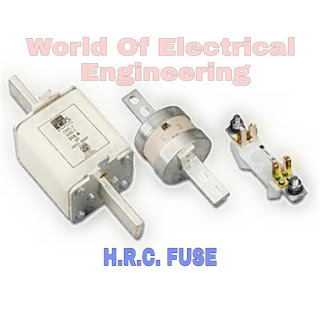Various Types of Fuse!!! And How it works???
 |
Various Types of Fuse!!! And How it works??? |
- We know that the main function of fuse is the protection of electrical equipments against high load current and any fault.
- There are generally three types of Fuse which is shown below
- Rewireable Type Fuse
- Cartridge Type Fuse
- H.R.C. Type Fuse
- All the the three types are described in detail below....
 |
| KitKat Fuse | Types of Fuse |
- This type of fuse commonly used in house wiring. It is also known as kit kat type fuse.
- This type of fuse made of two porcelain parts
- Base and
- Fuse carrier
- The base is connected with switch board.
- Incoming wire is inserted from the one side and directly connected to the terminal wire.
- Outgoing terminal is taken from the other terminal and also is called onward connection.
- In base area, two terminal are connected through fuse wire which held in the fuse carrier.
Advantages of rewireable Type Fuse
- Replacement of fuse is very easy.
- Negligible cost
- Removal of fuse is very easy
Disadvantages of rewireable Type Fuse
- Breaking capacity is very low.
- We can't use it for high current.
- True value of fuse element is very difficult to determine.
2. Cartridge Type Fuse
 |
| Cartridge Fuse | Types of Fuse |
- This type of fuse have a totally enclosed area like a tube shape.
- The fuse wire is carried by the container and fill with powder which is sealed at its endside with metallic material.
- The perfect insulating path is provided by the power for the fuse which helps to absorb the arc when the blowing up of fuse.
- This type of fuse generally used at 415v power supply.
Advantages of Cartridge Fuse
- More accurate
- The fuse element is non-deterioration.
Disadvantages of Cartridge Fuse
- Cost is high for replacement
- This type of fuse is not very economical.
3. High Rupturing Capacity Fuse
 |
| H R C type fuse | Types of Fuse |
- This type of fuses are used for heavy load at distribution system where heavy current can be flow.
- This type of fuse know as HRC Fuse very well.
- Operation of this type of fuse is very fast and also it will be absorb the heat very fast which is produced by the arc.
- HRC fuse consists ceramic cylinder ahaps body which resist the heat and consist heavy copper contacts at main body.
- Cylindrical body filled with non combustible powder which absorb the arc.
Advantages of HRC Fuse
- More accurate rating.
- High current breaking safely.
- Operation is very fast.
- It will need to replace after each operation.
- So very costly.
May You like to read this article related to this article 👇👇👇

Good
ReplyDelete